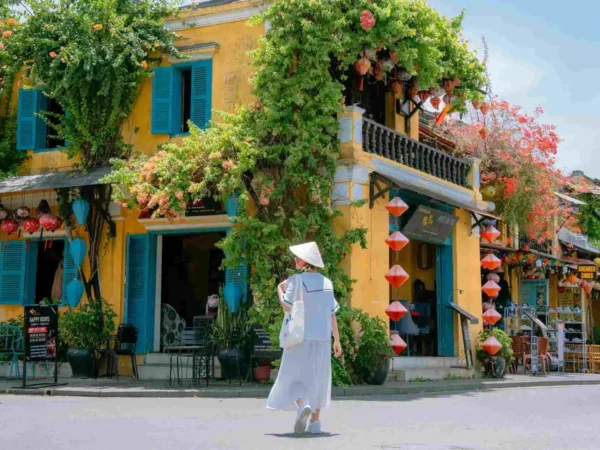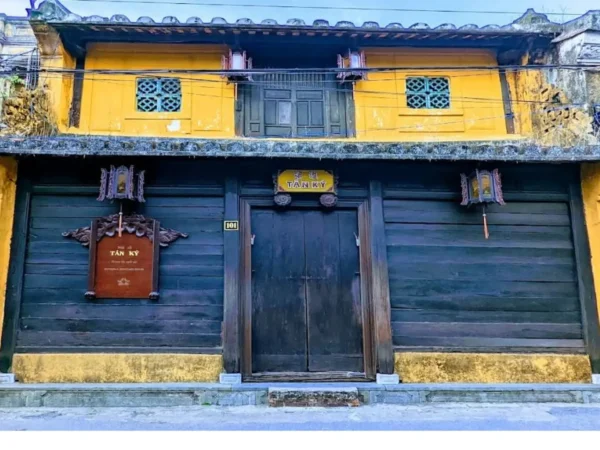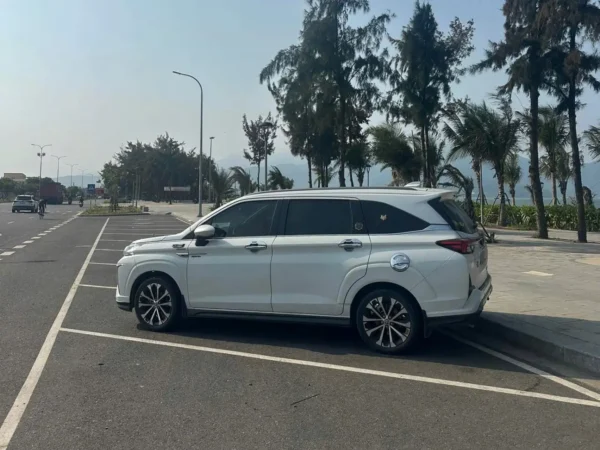Japanese Covered Bridge Radiates Rich Cultural Heritage
Do you like to visit places that are beautiful and full of stories? If yes, you will really enjoy the Japanese Covered Bridge in Hoi An! This small city has a special bridge that many people love to see. The bridge is old and famous. It has a roof, so you can walk on it even when it rains. When you step on the bridge, it feels like a walk into the past. It is calm, colorful, and perfect for everyone.
Overview of the Japanese Covered Bridge
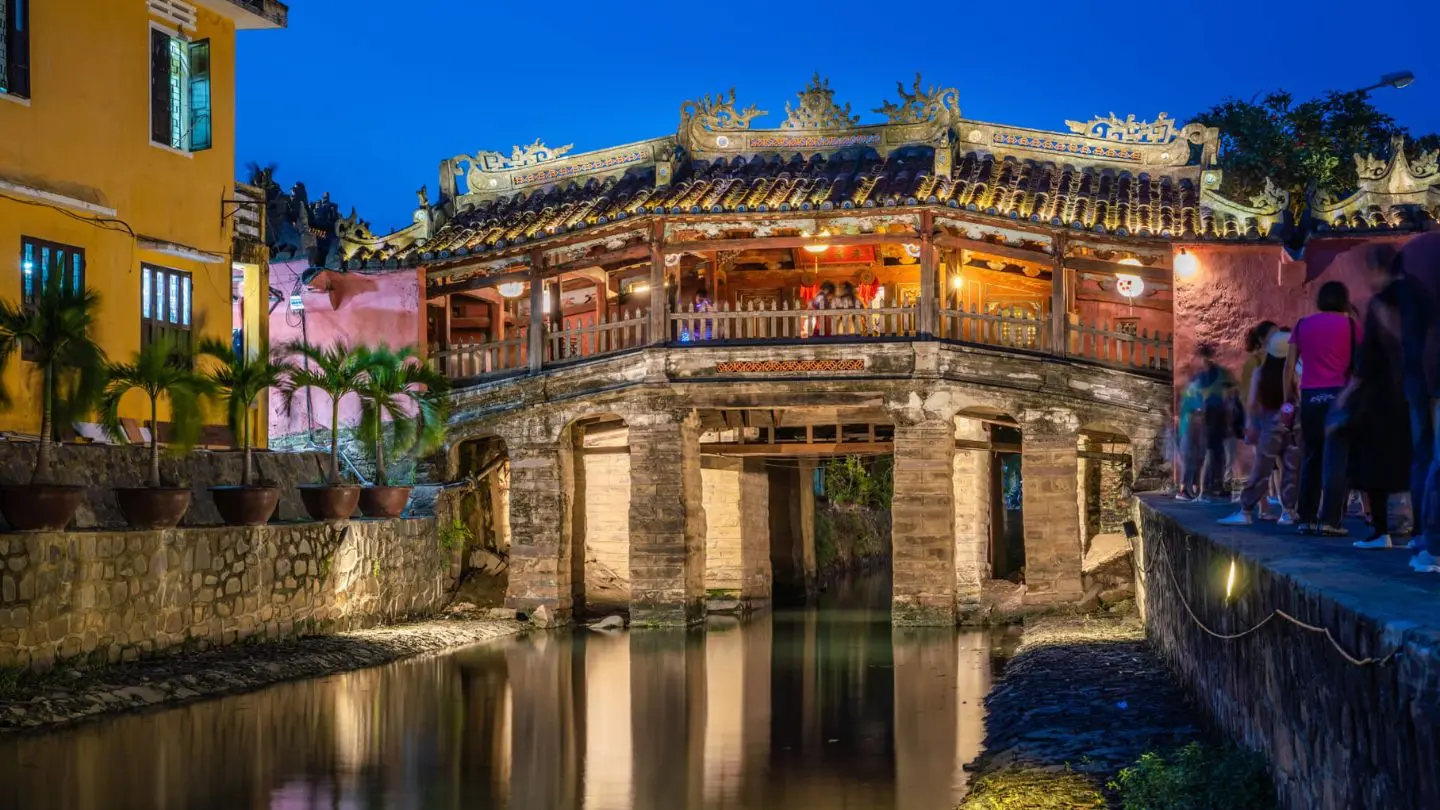
- Address: Nguyen Thi Minh Khai Street, Minh An Ward, Hoi An, Quang Nam Province
- Opening hours: 24 hours every day
- Tickets: free
The Japanese Covered Bridge, also known as Chùa Cầu or Lai Viễn Kiều, is a charming pedestrian bridge built by Japanese merchants around the late 1500s or early 1600s. It spans about 18 meters across a narrow canal and has a curved wooden roof with a small temple built on top. On each end, you will see statues of a dog and a monkey, thought to guard the bridge and honor local legends.
If you’re looking for a complete Hue travel experience without the hassle of booking transportation, all at a reasonable price and great quality — just click here! We’ve got you covered!
History of the Japanese Covered Bridge
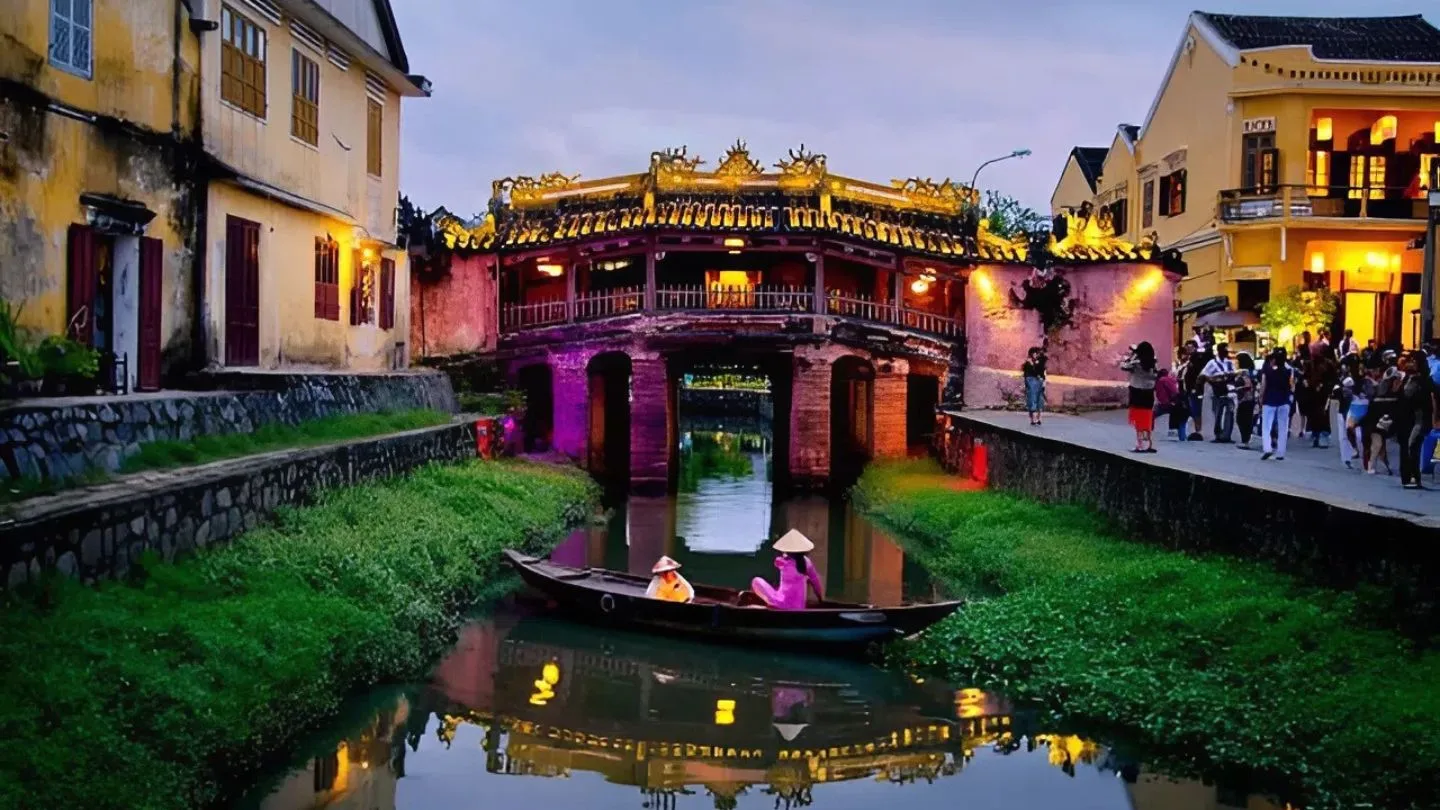
Locals also call it Chùa Cầu, and it’s one of the most famous spots in the old town. The bridge was built way back in the 17th century, thanks to help from Japanese traders who lived in Hoi An at the time.
What’s really cool is that there’s a legend behind it. People believed that a huge monster named Namazu lived under the earth. Every time it moved, it would cause earthquakes and floods. The legend says its head was in India, its body ran through Vietnam, and its tail was in Japan. So when the bridge was built, people believed it was like placing a magic sword on the monster’s back – to keep it still and protect everyone in those three countries. Pretty wild, right?
Later on, in 1719, a Vietnamese lord named Nguyen Phuc Chu came to visit the bridge. He loved it so much that he carved a name for it at the entrance in Chinese characters. The name meant “The bridge that welcomes guests from afar” – which is such a warm and lovely thought. And because the bridge was mainly built by the Japanese, people have called it the Japanese Bridge or Japanese Covered Bridge ever since.
Structure of the Japanese Covered Bridge
1. Location and Size – A Bridge That Connects Cultures
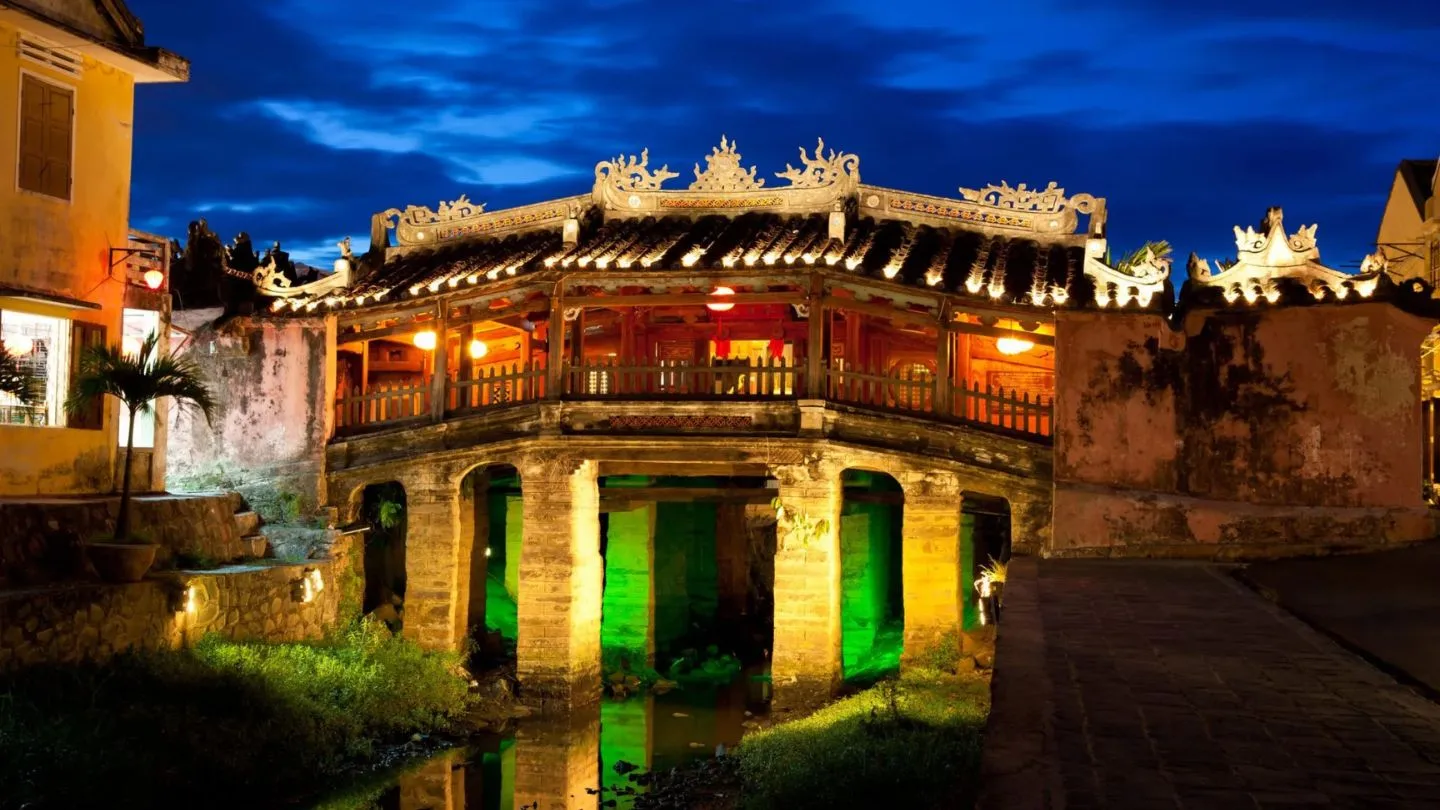
- The bridge is 18 meters long, short in size but big in meaning.
- It connects Tran Phu Street (the Chinese quarter) and Nguyen Thi Minh Khai Street (the Japanese quarter).
- It crosses a small part of the Thu Bon River, adding to the calm and peaceful look of the area.
👉 Meaning: This is not just a physical bridge, it’s a symbol of connection between different cultures (Japanese, Chinese, and Vietnamese). It shows how people from different places once lived and traded together in harmony in Hoi An.
2. Materials – A Mix of Strength and Beauty
- The bridge is built mainly with red lacquered wood for the top and sides.
- The base is made of strong stone to hold it steady over time.
👉 Meaning: The use of wood and stone reflects the typical style of East Asian architecture. Wood gives beauty and warmth; stone gives strength. This balance shows how the builders wanted both art and function in one structure.
3. Roof Design – A True Japanese Touch with Vietnamese Spirit
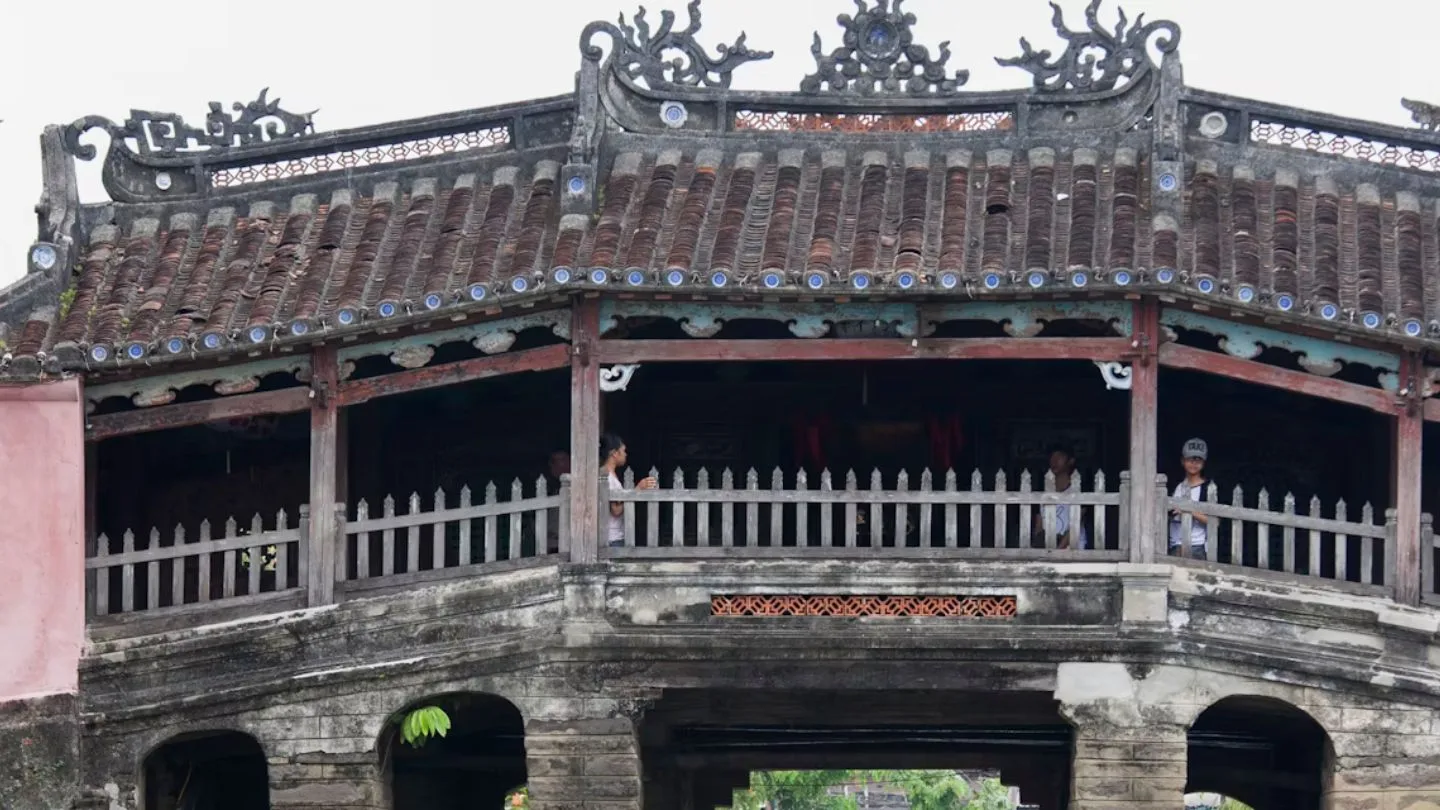
- The bridge has a curved roof that covers the entire walkway — very common in Japanese temples and houses.
- The roof is decorated with yin-yang patterns, which are symbols of balance and harmony in Vietnamese culture.
👉 Meaning: The curved roof is the most Japanese element of the bridge. But the yin-yang details connect it to Vietnamese beliefs. This mix tells us that the bridge is not only Japanese – it’s a cultural blend, made for everyone in the town.
4. Inside the Bridge – A Place to Pause, Not Just Pass
- There are small corridors and benches on each side where people can sit and relax.
- Inside the bridge, there is a small temple, which is separated from the walkway by a thin wooden wall.
👉 Meaning: Unlike many bridges used only for crossing, this one invites people to slow down and enjoy the moment. It is both a resting place and a spiritual space — something very unique and deeply rooted in Vietnamese traditions.
5. Animal Statues – Not Just Decoration
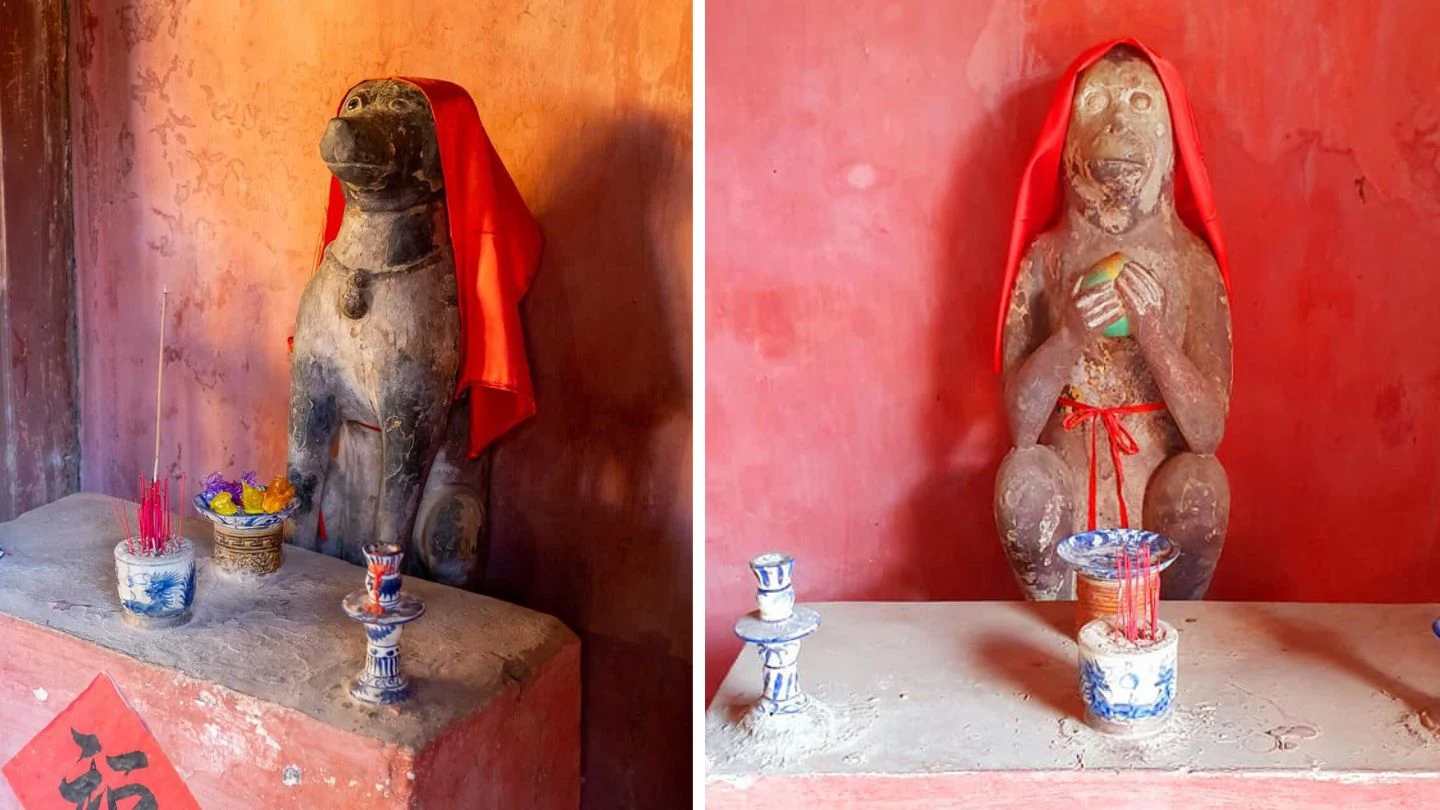
- At the entrance, there is a statue of a dog.
- At the exit, there is a statue of a monkey.
- In Japanese belief, both animals are seen as protective spirits.
- Some stories say the bridge was started in the Year of the Monkey and finished in the Year of the Dog (based on the lunar calendar).
👉 Meaning: These statues are more than just art – they are symbols of protection, showing care and respect for the spiritual world. They also give a hint about the historical timeline of when the bridge was built.
Interesting Facts About the Japanese Covered Bridge
Before you visit the famous Japanese Covered Bridge in Hoi An, here are some fun and meaningful facts to help you understand why this special bridge means so much to both locals and travelers.
1. A National Icon – The Bridge Appears on Vietnam’s Money
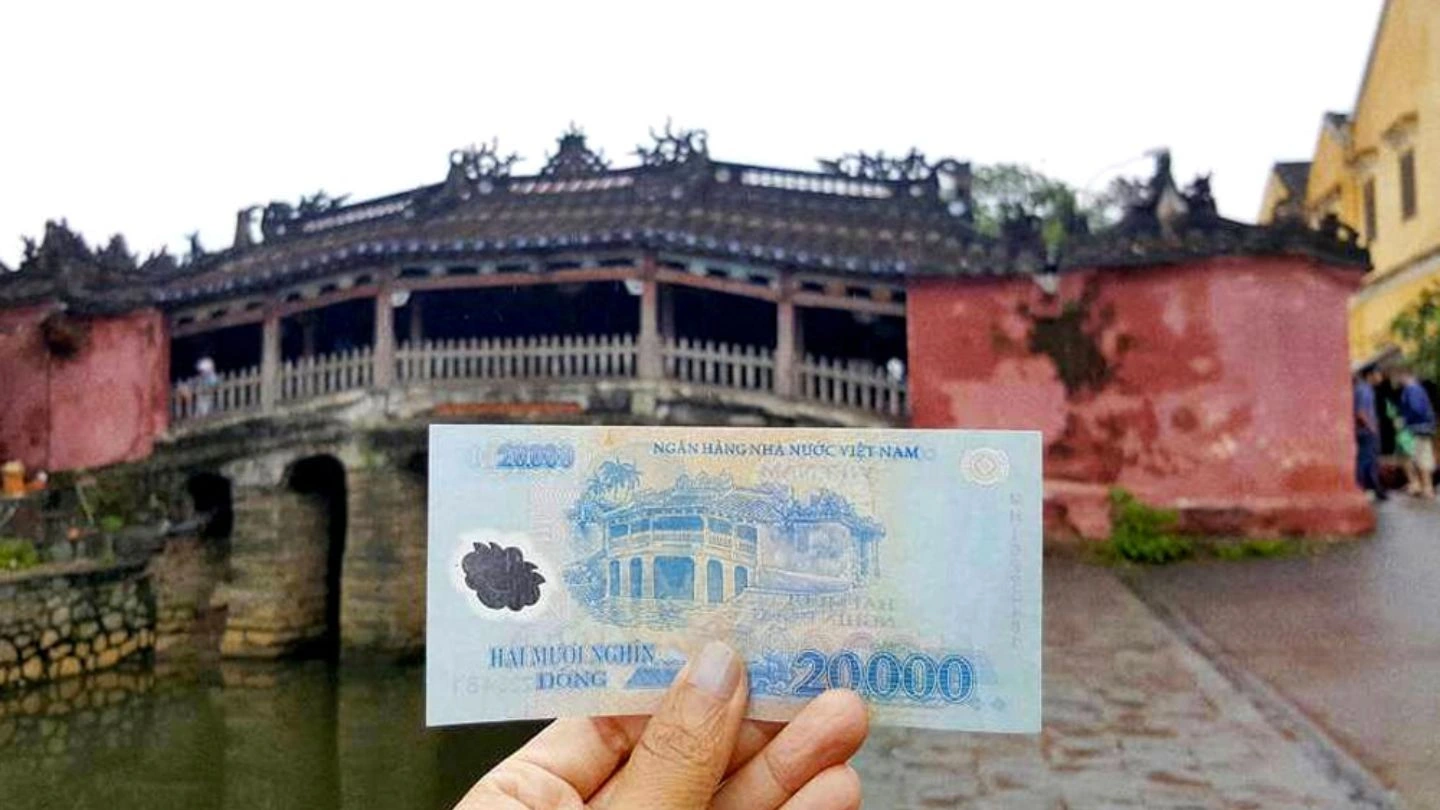
The Japanese Covered Bridge is more than just a beautiful spot – it’s a symbol of Hoi An itself. In fact, it was chosen to be featured on the back of the 20,000 VND banknote! This shows how important the bridge is to Vietnamese culture and history. It’s not only a tourist attraction, but also a proud national treasure.
2. Not a Usual Temple – No Buddha Inside
Unlike most temples in Vietnam, this one does not worship Buddha. Instead, it honors Tran Vo Bac De, the northern god of happiness, health, and wealth. For the local people of Hoi An, this makes the bridge not just a scenic spot, but also a sacred place to pray for good luck and peace of mind.
3. Two-in-One: A Temple and a Bridge
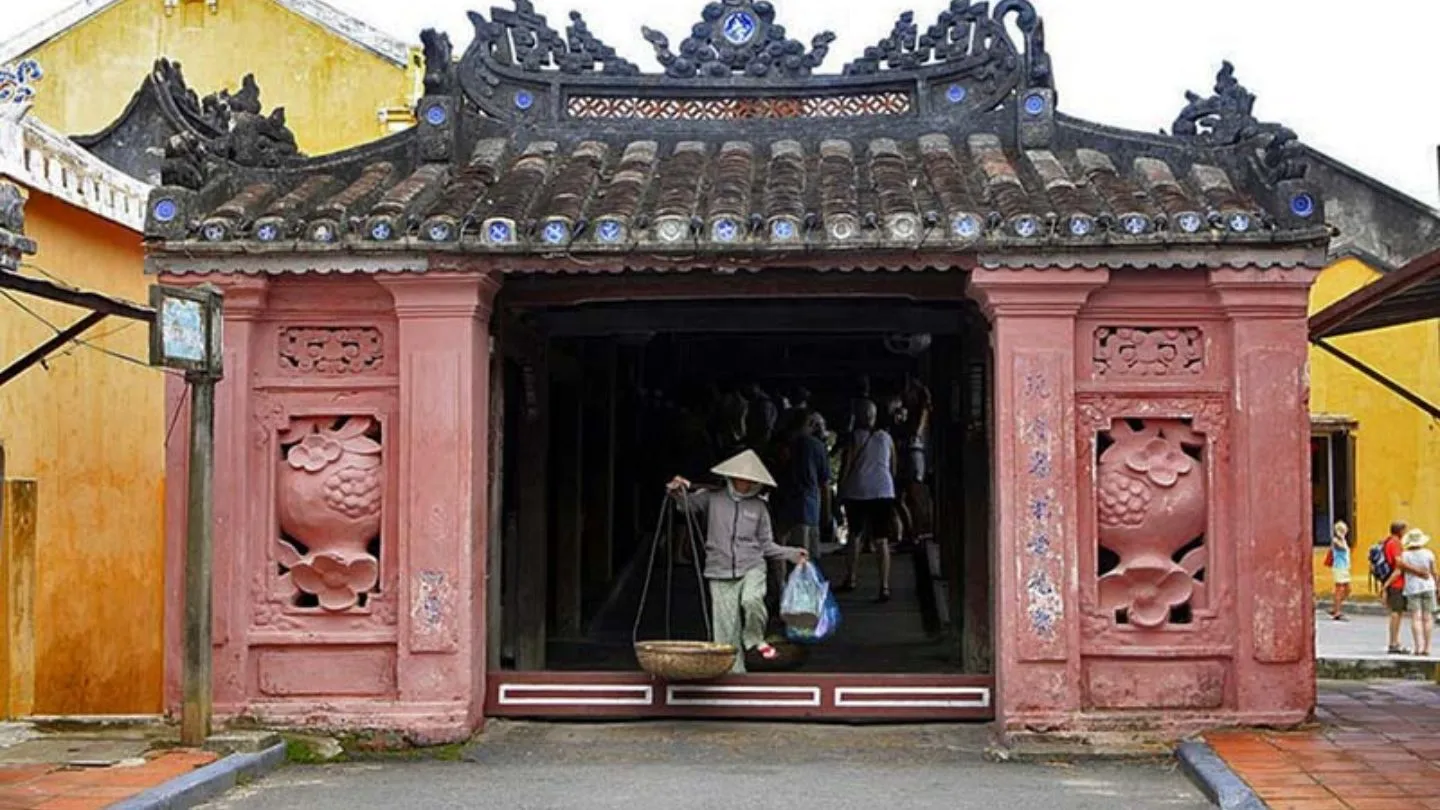
The structure has two separate parts:
- The bridge, which was built first to cross a canal of the Thu Bon River.
- And the temple, added about 60 years later, placed right on the bridge’s north side.
This is why locals call it “Chùa Cầu” (“Chùa” = temple, “Cầu” = bridge). Both parts together create one unique and spiritual landmark you don’t want to miss.
4. Built by History, Loved by All
The bridge was built by the Japanese community in the 17th century, during a time when Hoi An was a busy trading port. It’s one of the very few bridges in the world that also houses a temple, and even fewer still that blend Vietnamese, Japanese, and Chinese styles so beautifully. This mix of cultures is one reason the bridge feels so magical.
5. A Photographer’s Dream
If you love photography or simply enjoy beautiful sights, don’t forget your camera! The Japanese Covered Bridge looks amazing in the early morning light and even more magical at sunset. The curved roof, wooden beams, and old lanterns make every corner photo-worthy.
How To Get To the Japanese Covered Bridge
To reach the Japanese Covered Bridge from Hoi An or Hanoi, travelers can walk from the Old Town or travel via the following options:
1. Hanoi to Hoi An
To visit the Japanese Covered Bridge in Hoi An from Hanoi, you have three main options:
- By Train: There’s no direct train to Hoi An. Instead, you take the overnight train from Hanoi to Da Nang—journeys typically take 16–18 hours (Trains SE1, SE3, SE5, SE7) and offer classes like soft seats or sleeper cabins ranging from US $25 to $80 depending on the train and berth type. Once in Da Nang, take a taxi or shuttle (~45 minutes) to reach Hoi An and then walk to the bridge.
- Overnight Sleeper Bus: A direct sleeper bus from Hanoi to Hoi An takes around 17–20 hours and costs about US $20–30 (~450 000–600 000 VND). These buses have reclining bunks in air-conditioned cabins but may feel cramped and noisy for taller travelers or light sleepers. Some travelers report that beds cater to smaller frames, making sleep difficult if you’re taller than average.
- VIP Cabin Bus: Offers private single or double cabins on modern sleeper buses departing Hanoi (often around 17:00–19:30). Travel time is about 14–15 hours, with fares around US$22–30 (~500 000 VND). Amenities include leather mattresses, curtains, personal LED screens, USB ports, Wi‑Fi, bottled water, and towels – offering more comfort and privacy than standard sleeper buses.
Once you arrive in Hoi An Ancient Town, the Japanese Covered Bridge is located in the heart of the old town, just a short walk from many hotels and public squares.
2. Hue to Hoi An
Distance is about 125–130 km, and travel time is typically 3 to 4 hours, depending on the option.
- Bus or van: Direct buses run daily and cost around 250,000 VND (~$10–12); travel time is about 3–4 hours.
- Train + transfer: Take a train from Hue to Da Nang (~2.5–3 hours, ticket ~100,000–120,000 VND or $4–5), then catch a taxi or local bus (~1 hour, ~150,000–200,000 VND or $5–8) to Hoi An.
- Private car/taxi: Direct ride from Hue to Hoi An (~3 hours), or ~5–7 hours with scenic stops like Hai Van Pass, Lang Co Beach, Lap An Lagoon, or Marble Mountains; cost typically 1,500,000 VND ($55–70 USD)
Tips to Visit the Japanese Covered Bridge
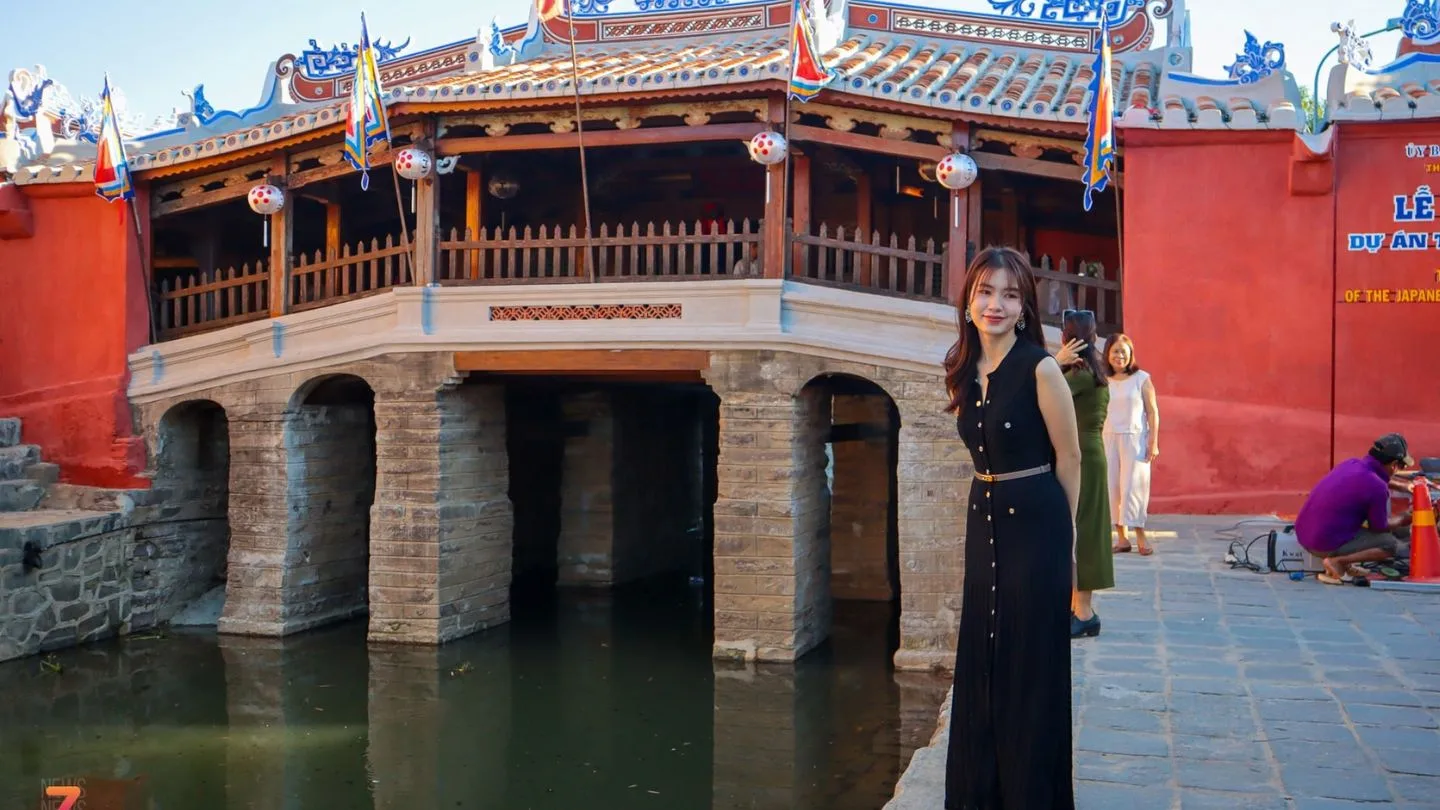
- Try to go early in the morning or late in the afternoon. It’s cooler, less crowded, and the light is perfect for photos.
- Don’t forget to buy the Hoi An Old Town ticket (about 120,000 VND). That’s your pass to visit the bridge and other cool places nearby.
- Wear comfortable shoes and light clothes. You’ll be walking around a lot, and it can get pretty warm.
- Keep it quiet and respectful when walking on the bridge. There’s a small temple inside, so it’s good to stay calm.
- If you’re curious about the history, a local guide can tell you some really interesting stories.
- After visiting the bridge, take time to explore around – there are cute old houses, temples, and fun little shops.
- In the evening, try a lantern boat ride. It’s peaceful, beautiful, and kind of magical.
Conclusion
The Japanese Covered Bridge is more than just an old bridge. It is a quiet and beautiful place where you can feel the history of Hoi An. Many people come here to walk, take photos, and enjoy the peaceful view. The bridge has a special charm that makes people smile. If you visit Hoi An, this is a place you should not miss. It is perfect for families, friends, and anyone who loves beauty and calm moments.


